Welcome to a treasure box of digitized documents, objects and imagery from UF’s Cuban archives at Smathers Libraries’ Special Collections! Here we present archival materials that span different periods of Cuban history and are also unknown to most historians and the public alike. We hope to inspire their use in classrooms around the world and to further knowledge of the rich political culture of Cuba. Gems of the Archive will itself become an archive as new examples are uploaded monthly.
All items curated by Lillian Guerra with the assistance of Miguel Torres Yunda.
- Guayo’s Collection: El Bogotazo
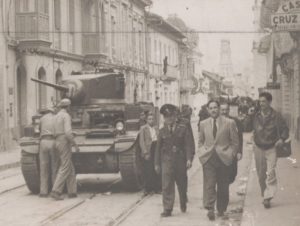 Read more
Read moreOn April 9, 1948, the assassination of Liberal Party presidential candidate and congressman Jorge Eliécer Gaitán provoked an incendiary riot in downtown Bogotá. Military and police repression combined with violent protests left over three thousand dead. Working as a photojournalist who had planned to cover an inter-American diplomatic congress, Eduardo “Guayo” Hernández witnessed and fearlessly documented these tragic events.
- Self-Portrait of an Enslaved Woman
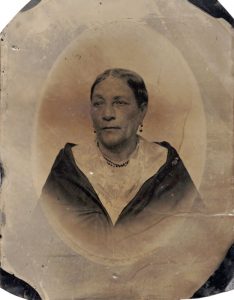 Read more
Read moreUnusual for its large size (5”x7”) and the rarity of its subject, this tin type was made in Trinidad de Cuba in the early 1870s. I acquired it from a man I caught selling national antiquities to tourists. When I stopped the sale by explaining to his buyers why such an image should be treasured by Cubans rather than purchased like a tourist trinket for display in France, he quickly demanded that I put my money where my mouth was.
- Turn-of-the-Century Geisha Fad
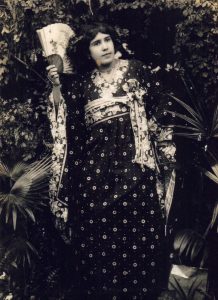 Read more
Read moreI grew up with this 1898 portrait of Mercedes Sotolongo Suárez del Villar, my then fifteen-year-old great-grandmother-to-be, better known as “Cuca.” Like virtually anyone who saw it, I was struck by the oddity of her dress: why was she wearing the clothing of a Japanese geisha? Only later, as a doctoral student working in archives, did I discover that geisha-themed Sweet Fifteen parties were all the rage in Cuba among white elites from the late 1890s through the first decade of the Twentieth Century. The fact that real-life geishas’ primary task was to entertain men—and for money no less—made Cuca’s choice of dress, so early in the fad, cutting edge. Her confident rebel pose was also truly rebellious: elite, white girls worried about their sexual honor did not normally take such risks with their reputation, preferring to appear demure on camera. If Cuca’s place in the family lore is right, however, she was every bit the feminist her peers were not. Cienfuegos, 1898.
- Cuban Kindergarten
 Read more
Read moreThis photograph shows four devoted Kindergarten teachers with their charges on an excursion to a park in Cienfuegos in 1941. The teachers include my great aunt Olga Sotolongo (second and tallest adult from left) and her cousin Silvia “Chacha” Suárez del Villar (first adult on the right). Like many women of the middle classes who chose not to marry, they survived by making the most of their education and joining Cuba’s expanding public school system as teachers. Unlike private schools which became increasingly segregated by class and therefore by race in the 1940s-50s, public schools preserved the anti-racist meritocratic aspirations on which the Cuban Republic was founded. Standing at the very front in overalls is my four-year-old uncle Julián and my always intellectually precocious two-year-old mother Luisa. Cienfuegos, 1940.
- First Tape-Recorded Interview of Fidel Castro in Sierra Maestra, April 1957
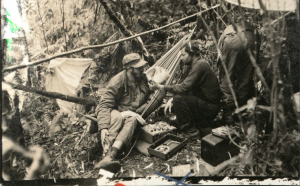 Read more
Read moreHerbert Matthews’ February 1957 blockbuster report in the New York Times of the survival of Fidel Castro and 18 members of an 82-man invasion force inspired young journalist Andrew St. George to go to the Sierra Maestra himself. With Coronet magazine’s funding and CBS’s heavy recording equipment, St. George made contact with clandestine activists of Fidel’s 26th of July Movement in New York and Miami to book the trip. Once in Oriente, top local organizer Celia Sánchez provided a safe house and press pass. Felipe Guerra Matos served as guide. Unlike Matthews, who spent less than a day with Fidel’s troop, St. George spent nearly two months, from mid-April to early June 1957. It was the first of six trips he made to the Sierra. St. George spent more time with the Rebel Army than any other journalist. Photograph by Ernesto “Che” Guevara using St. George’s camera.
Read more "First Tape-Recorded Interview of Fidel Castro in Sierra Maestra, April 1957"
- Is that Fidel Castro?
 Read more
Read moreOnly at the insistence of the camp medic, Ernesto “Che” Guevara, did Fidel Castro finally concede a taped interview to St. George. He quickly convinced Fidel Castro of the value of addressing the English-speaking world directly. Castro subsequently wrote “Why We Fight”, the only single-authored manifesto of his entire time in the Sierra Maestra (December 1956-December 1958), which St. George then published in Coronet and helped the 26th of July Movement translate and distribute world-wide. In this text, Fidel Castro declared that he had “no plans for the expropriation or nationalization of foreign investments here”. He argued instead for the radical amelioration of the poverty generated by Cuba’s massive, foreign, and domestically-owned sugar estates. This “economic sickness” had to be “cured without delay, lest it fester and become a breeding ground for Communism,” said Fidel Castro.
- St. George’s Gift of a Camera to Che Guevara
 Read more
Read moreHalfway through St. George’s first trip to the Sierra Maestra, Che explained he had once made a living as a street photographer in Mexico after fleeing Guatemala and a job in the agrarian reform division after a CIA coup toppled Guatemala’s elected government. St. George then gifted Che Guevara with one of his three cameras and some film. Che expressed sheer delight with the gift. He also took several well-crafted pictures of St. George in the Sierra that he later used to prove his own presence there. On his second trip in the fall of 1957, St. George also began to bring back rolls shot by Che of daily life in the Sierra, the surrender of enemy soldiers, and the army officers who switched sides from Batista to Fidel during the war. St. George also provided the 26th of July Movement’s propaganda wing with many pictures of his own.
- St. George and Anti-Batista Activists at the United Nations
 Read more
Read moreIn 1958, a large group of 26th of July Movement activists protested the presence of a Cuban delegation appointed by dictator Fulgencio Batista at a voting session of the United Nations in New York. I first found a photo of the whole group at the University of Florida and published it in Heroes, Martyrs, and Political Messiahs in Revolutionary Cuba, 1946-1958 (Yale University Press, 2018) without knowing the photographer was Andrew St. George. To my surprise, his private papers included this close-up shot of a clean-shaven (and extra-slender) St. George, probably fresh from a trip to the Sierra Maestra alongside three activists. Widely circulated in the opposition press, these images testify to St. George’s personal identification with the cause of justice and democracy in Cuba. Photograph by unknown activist using St. George’s camera.
Read more "St. George and Anti-Batista Activists at the United Nations"
- Caught in Color: 1st January 1959
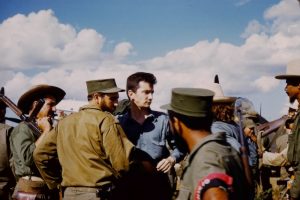 Read more
Read moreAlthough Kodak produced its first color film in the early 1940s, most photographers only reluctantly used it, in part because mid-twentieth-century readers were accustomed to magazines with articles whose texts did not “compete” with accompanying photos unless they were explicitly designed as “picture stories.” Many editors never fully trusted St. George because they were predisposed to favor native English speakers to write their articles. St. George nonetheless produced full-color covers for Life magazine’s first January 1959 coverage of the 26th of July Movement’s takeover of the state. Images like these represent rare, never-before-published shots in the color of New Year’s Day, 1959. Here, Fidel Castro meets with longtime underground activist and fellow lawyer Armando Hart, backed by anti-communist and former Orthodox Party member Luis Orlando “Pupo” Rodríguez, Fidel’s personal bodyguard, holding a semi-automatic weapon. A second portrait shows Fidel and soldiers riding on a jeep at the crack of dawn, just before jumping into an eight-day “caravan of triumph” from Santiago to Havana.
- Exhausted Soldiers and a Short-Term Anti-Communist President
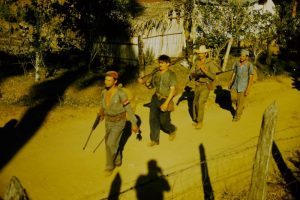 Read more
Read moreOne of the characteristics of St. George’s photography is that it often resisted the mythification of revolutionary reality. Here, his lens reveals dusty, exhausted Rebel Army soldiers marching through a town in Oriente province on New Year’s Day, 1959. St. George also regularly photographed Judge Manuel Urrutia, hand-picked by Fidel Castro to be President of the Republic, in the first weeks of 1959 when few other reporters seemed interested. His trust in Urrutia lasted and deepened, especially when Urrutia’s efforts to echo Fidel Castro’s own disavowal of Communism got him in trouble. In June 1959, Urrutia’s assertion on national television that the government was “anti-communist” elicited rebuke from Fidel Castro who attacked him in turn as morally weak and incapable of rule. St. George subsequently hand-delivered Urrutia’s letter of resignation to Fidel. Urrutía’s marginalization contributed to Fidel’s power and ultimately, his ability to rely on Communists, not the members of his own 26th of July movement, to rule unconditionally.
Read more "Exhausted Soldiers and a Short-Term Anti-Communist President"
- The Word in Action
 Read more
Read moreIn the first three years after the 1959 Cuban Revolution, no other photographer was as good at capturing the drama, charisma and sheer physical exertion typical of any of Fidel Castro’s hours-long speeches. In these frames, St. George relied on rapid-dire photographic methods to document Fidel in action. They evince a cinematographic quality.
- Rubirosa, the Original “Latin Lover” and Fidel Castro, January 1959
 Read more
Read moreDominican dictator Rafael Trujillo’s favored son-in-law, Porfirio Rubirosa, somehow managed to turn up at a Presidential Palace reception held for Fidel Castro, who had just completed his 8-day caravan-of-triumph from Santiago to Havana. Because Andrew St. George had written an exposé on Trujillo’s 1956 kidnapping and assassination of Jesús Galíndez, a Basque writer and legal expert on Trujillo’s terror regime at Columbian University, the fact of Rubirosa’s presence at this very moment was surely surprising. One wonders why exactly he was there.
Read more "Rubirosa, the Original “Latin Lover” and Fidel Castro, January 1959"
- Che Guevara on National Radio
 Read more
Read moreSt. George took these pictures in either late 1959 or early 1960 as Ernesto “Che” Guevara addressed a live radio audience at the national headquarters of Cuba’s largest labor union, the Confederación de Trabajadores Cubanos . By then, the CTC had refused to accept any Communist Party participation in their leadership on multiple occasions, in part because the Communists had collaborated with, not opposed, the rightwing dictator Fulgencio Batista. As late as May 1960, one union vote after another refused to endorse any Communist nominees in the CTC’s national elections. Then Fidel Castro (who publicly continued to disavow Communist alliances) and his closest advisors adopted another strategy: they relied on local CTC elections that could be announced on the fly rather than scheduled elections to secure their candidates. Uninformed workers who took the system for granted soon found that they had lost control of leadership in unions to the Communists. The result was dramatic: workers lost the right to strike, among other means of protest. Always the prophetic witness, St. George took these pictures in a moment when he might not have recognized their irony: here the Marxist Che Guevara accepts and rewards the entrepreneurialism of a young girl who ...
- José Ignacio Rivero, last director of Diaro de la Marina
 Read more
Read moreA pro-business newspaper whose 128 years of publication in Cuba gave it a certain cache, Diario de la Marina lost its freedom from government interference in its content and publication in May 1960. Then, Diario de la Marina and other papers, including its ideological rival Prensa Libre, were intervened, and shuttered by Communist Party-organized militias. Although Diario de la Marina had not publicly opposed Fulgencio Batista’s government nor had its editors taken regular handouts from Batista, its reputation for straight-shooting surely prompted St. George to interview José Ignacio Rivero, its final owner-director and chief editor, about Cuba’s options in the face of the paper’s inevitable nationalization.
Read more "José Ignacio Rivero, last director of Diaro de la Marina"
- Fidel Castro and Armando Hart Toast Anastas Mikoyan
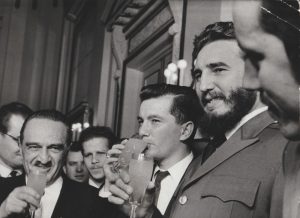 Read more
Read morePerhaps naïvely, most Cubans believed the revolutionary government’s story that the Soviet Vice Premier Anastas Mikoyan had come to Cuba in February 1960 in order to promote an exhibit of Soviet Culture in Havana. His real motives were to assist Fidel Castro in deepening Cuba’s ties to the Soviet bloc, particularly in areas of trade, security, and intelligence training. Yet Fidel Castro’s government went to great lengths to portray Mikoyan’s visit as evidence that Cuba had simply consolidated its national sovereignty and could now trade freely with both “The West” and “The East”.
Read more "Fidel Castro and Armando Hart Toast Anastas Mikoyan"
- Government Rally outside of Santiago, Oriente in 1960
 Read more
Read moreUnlike the previous year when Cuba’s nationalist (but still pro-capitalist) policies generated an economic boom and mass support for the state, the radicalizing policies of the summer of 1960 produced palpable tensions and outright opposition to Fidel Castro’s version of revolution. Held on July 26, 1960, this rally to commemorate the seventieth anniversary of Fidel’s failed Assault on the Moncada Barracks took on an oddly forced tone. Held outside the city of Santiago in a remote field in eastern Cuba, the rally entailed mobilizing hundreds of thousands of people to the site, including an unprecedented number of invited foreign Leftists from Latin America and the United States. Compared to its predecessor in July 1959, which relied on civic volunteers to coordinate the visit of 500,000 formerly landless peasants to Havana and their stays in private homes, the 1960 rally lacked the euphoria and spontaneity of citizen-led organization.
Read more "Government Rally outside of Santiago, Oriente in 1960"
- The Myth of the Revolution Shakes New York

For ten days in September 1960, Fidel Castro led a large delegation of top Cuban leaders to New York City where he was slated to address the General Assembly of the United Nations. Coming on the heels of an unexpected, blanket nationalization of all foreign-owned businesses that August, the trip catalyzed a frenzy of support. Exiled Cubans who had fought the Batista dictatorship, Puerto Ricans, African Americans, and white progressives lined the streets. Everywhere they hailed Fidel Castro as a liberator and redeemer whose struggle against US imperial policies in Latin America inspired their own fight for rights and justice. Although originally booked at the Shelbourne Hotel, the Cuban delegation soon moved to Harlem’s Hotel Theresa where their presence deliberately illuminated the greatest evidence of the United States’ hypocritical claim to being the world’s leading democracy: legal segregation and anti-Black racism. In these photos, jubilant crowds surge at the sight of Fidel at the airport and on the streets of Harlem; Nation of Islam representatives encounter hostility an all-white police detail in the lobby of the Hotel Theresa; and Fidel Castro, together with Celia Sánchez, Cuban diplomats, and security, arrive at the United Nations for his speech.
- Communists and Opera Fans, April 1959
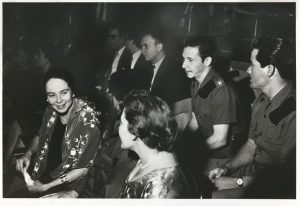 Read more
Read moreHere Vilma Espín, Ernesto “Che” Guevara, Che’s wife Aleida March, Raúl Castro, Alfredo Guevara and Guillermo Cabrera Infante are seen attending a performance of the famed soprano Elizabeth Schwartzkopf during Fidel Castro’s good will tour of the northeastern United States in April 1959. Ironically, Schwarzkopf had been a member of the Nazi Party who had also appeared in feature films crafted by Hitler’s Minister of Propaganda, Joseph Goebbels. This fact was surely not lost on the anti-Nazi fighter Andrew St. George.
- The CIA’s Answer to Fidel’s Revolution
 Read more
Read moreIn early 1961, St. George photographed these young Cuban exiles who had recently been recruited for “Brigade 2506”, an armed force of about 1,500 men whom the CIA trained and financed to invade Cuba and ultimately, they hoped, to topple the government. As part of the plan, the CIA secretly developed what was supposed to be a transitional, pro-United States government under the name Movimiento de Recuperación Revolucionaria , led by Manuel Artime. Today both the CIA’s plot and its abysmal failure as a military operation are better known by the location of the invaders’ landing site at the “Bay of Pigs”. As these images bely, MRR members ranged dramatically in age and experience. St. George interviewed some of them at a hotel that served as a “barracks” in South Miami.
- Life and Death in Anti-Castro Miami
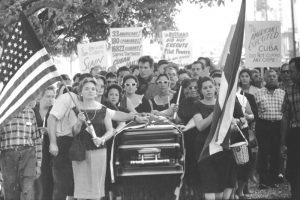 Read more
Read moreOver the decade of the 1960s, St. George was repeatedly baffled by how little attention the national media paid to the open warfare that thousands of Miami Cubans—with and (later) without CIA funding—were conducting against Communist-ruled Cuba. This funeral procession likely took place in 1960 when the body of a Cuban man, charged with working for US intelligence, was repatriated following his execution. Mourners stitched the Cuban and American flags together over his casket in an open-air ceremony before holding a procession and rally near a bust of José Martí in a Miami park.
- Exile commando force at secret training facility
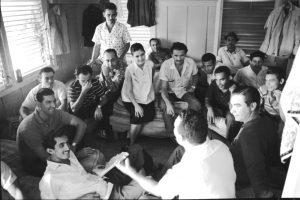 Read more
Read moreOne of many photographs St. George made of the same event, the image appears innocuous: its subjects—almost all male except for the young woman at its center—seem to be holding a social gathering. Yet the group was engaged in high-intensity training and political discussions at a secret facility somewhere in South Florida. Meticulously, St. George documented its location and his own arrival there in a bi-plane, as if he were taking notes by taking photographs. The resulting portraits show how seriously some young exile groups took their mission to overthrow the Cuban regime, often spending months or even years of their lives committed to that one cause.
Read more "Exile commando force at secret training facility"
- Rolando Masferrer’s Private Army Trains in Miami
 Read more
Read moreBy the late 1960s, St. George had lost all hope that any armed exile group might succeed in toppling Cuba’s communist regime, particularly because he knew that such groups’ reliance on the United States, and often CIA funding, undermined their credibility—especially in Cuba. To his shock, one of the giants of the terror network on which Cuba’s former dictator Fulgencio Batista had relied began operating openly in Miami in 1965. Headed by ex-Senator, Spanish Republican exile, and Batista loyalist Rolando Masferrer, the militia took the same name it had once had in Cuba: Los Tigres. Famous for the atrocities they committed against civilians on behalf of Batista, Miami’s Tigres were mostly U.S. citizens. Their middle age and lackluster physical condition made them no less dangerous.
Read more "Rolando Masferrer’s Private Army Trains in Miami"
- “Government by Television”
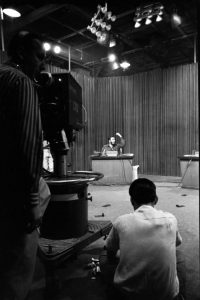 Read more
Read moreIn this contact sheet, St. George catches Fidel Castro’s theatrical style of speaking on Ante la Prensa, a Cuban version of the United States’ popular Meet the Press. One difference obvious to any viewer, however, was that invited speakers on the American show offered comparatively short and courteous responses to on-stage reporters, whereas Fidel Castro’s answers often lasted two to three hours (on what was formerly a 45-minute telecast). On these shows, Fidel regularly justified radical policy moves, denounced any critics, and demanded the resignation of officials he considered too democratic or independently minded—including many members of his own cabinet who had given their lives to the fight against Batista. In 1959, journalist Herbert Matthews called Fidel’s constant presence on TV and radio “government by television”.
- The Puzzle of Ernesto “Che” Guevara Solved
 Read more
Read moreAn earlier edition of Gems of the Archive featured this puzzle, manufactured and purchased by Andrew St. George in Cuba. Here we see the same puzzle in the context that explains why St. George found it so interesting. Surrounded by books that normalized hero worship in the pivotal year of 1960, it was one of many cultural instruments—some produced by state agencies and others for profit by local businesses—that mimicked the “one-man, one-state, one-way” ideology typical of fascist and communist rule. St. George had witnessed both political systems in Nazi-controlled Hungary and in Central Europe after the Soviet Union’s liberation became a permanent occupation after World War II.
- Guardian and Donor of His Father’s Legacy
 Read more
Read moreAlong with thousands of images of Cuba and Latin America, the Andrew St. George Collection also includes many intimate portraits of the photojournalist’s family from the early years of the Revolution when, together, they witnessed Cuba’s tumultuous transformation. No words can express the gratitude that all of us who study and love Cuba feel toward the donors of the Andrew St. George Collection. His sons and their families have entrusted priceless treasures of knowledge to the University of Florida. Thank you.
- TOYS THAT TEACH WHITE SUPREMACY
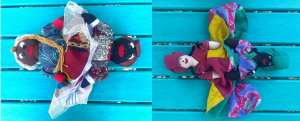 Read more
Read moreKnown in the US South as “topsy turvy” dolls because of their two-in-one design, dolls like these from Cuba differ fundamentally from ones I have seen at local Florida antique stores.
- CUBA’S 1961 CURRENCY CRISIS
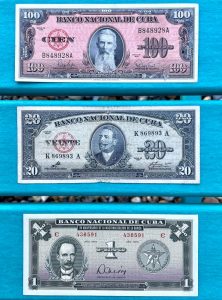 Read more
Read moreWhen I was a little girl growing up in Kansas, I often asked my mother to explain why she had left Cuba. Rather than speak in adult abstractions that flatly cited black-and-white reasons such as “communism,” my mother often referenced specific experiences she had before she left Cuba in 1964. They revealed the Castro regime’s authoritarian character and the average citizen’s powerlessness in vibrant, dramatic colors. For example, Mom said she quit her job in 1960 at the National Bank when the Cuban government announced it would retire Cuba’s republican-era currency and replace it with newly minted revolutionary bills. There was only one catch: no Cuban could exchange more than a few hundred pesos. When my mother and other bank employees were assigned to exchange new bills for old ones in the countryside and poor areas of Havana, however, they discovered that most peasants and many illiterate Cubans had never had bank accounts and kept their savings in cash. Thus, the maximum limit for exchanging only a few hundred republican-era pesos meant that tens of thousands of citizens lost their whole life’s savings! Bank workers like my mother were appalled. They were also charged with explaining this policy as a ...
- CATHOLIC COMMUNISM?
 Read more
Read moreAfter the Cuban state formally dropped its promotion of atheism in favor of official secularity in 1991, the Papacy successfully negotiated the right of the Catholic Church to edit and publish theological newsletters like this one, Vida Cristiana . Here, jornada had a spiritual purpose: it was a week-long call to prayer for the expansion of clerical ranks. The same editorial also justifies “one-man” paths to salvation, invoking Jesus Christ as the “one man” who could bring that about, as opposed to the apparent one-man, nearly forty-year rule of Fidel Castro himself. Similarly, page two of the newsletter examines whether “freedom” ...
- “The Wounded Island” (1980)
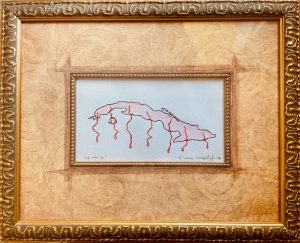 Read more
Read moreA mixed media watercolor monoprint, Isla Herida is the unique creation of Florencio Lennox Campello, born in Santiago de Cuba in 1956, as part of a printing assignment while the renowned artist was still a young student at the University of Washington School of Art.
- The Puzzle of Che Guevara (1960)
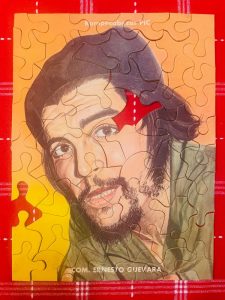 Read more
Read moreManufactured by a privately owned business in Cuba in 1960, this puzzle-portrait of Comandante Ernesto “Che” Guevara speaks to the market for hero-making propaganda and revolutionary memorabilia that citizens’ trust in the Revolution then represented.
- Communists and Opera Fans, April 1959